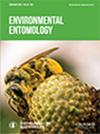Understanding the movement and dispersal patterns of released Fopius arisanus (Hymenoptera: Braconidae) parasitoids in a papaya orchard
IF 1.8
3区 农林科学
Q2 ENTOMOLOGY
引用次数: 0
Abstract
Implementation of augmentative biological control requires estimates of parasitoid dispersal from the release point to determine appropriate release density, spacing, and timing. This study evaluated the movement patterns of Fopius arisanus Sonan (Hymenoptera: Braconidae) parasitoids, which have historically been used to control invasive tephritid fruit flies. The wasps were released from the central point, and dispersal was monitored over time using parasitism in sentinel fruit and trap captures at 40 points radiating out from the center (15–240 m). The releases were conducted 4 times during June, July, September, and November 2006. The data showed that there were large declines in dispersal by distance. Parasitism was greatest closest to the release point, within 30 m. Parasitism was also greatest within the first 24 h of the release. After 1 wk, parasitism decreased from 41% to 1.5% within 30 m. These data correlated strongly with trap capture data, which also showed that parasitoid movement favored the SE region of our release site, roughly corresponding to the overall prevailing winds. Wind speed, relative humidity, and temperature all affected parasitoid movement during our trial, indicating the complex environmental factors that can affect release success. This is the first report of dispersal metrics for F. arisanus. Our findings are in agreement with other similar studies on braconid movement generally and suggest that frequent, high-density releases are most effective since the dispersal of F. arisanus is limited and retention in the environment is low. We discuss our results in the context of international augmentative biological control release programs.了解木瓜园中释放的 Fopius arisanus(膜翅目:腕足动物)寄生虫的移动和扩散模式
实施辅助生物防治需要估计寄生虫从释放点的扩散情况,以确定适当的释放密度、间隔和时间。本研究评估了 Fopius arisanus Sonan(膜翅目:蝙蝠科)寄生蜂的移动模式,这种寄生蜂历来被用于控制入侵的表皮蝇类果蝇。黄蜂从中心点释放,并利用寄生在哨兵果实上的寄生虫和从中心点向外辐射(15-240 米)40 个点的诱捕器捕获的黄蜂来监测黄蜂的扩散情况。释放活动在 2006 年 6 月、7 月、9 月和 11 月进行了 4 次。数据显示,随着距离的增加,扩散量大幅下降。离释放点最近的 30 米范围内寄生率最高。1 周后,30 米内的寄生率从 41% 降至 1.5%。这些数据与诱捕器的捕获数据密切相关,诱捕器的捕获数据还显示,寄生虫的移动主要集中在释放地点的东南部地区,与整个盛行风的风向基本一致。在我们的试验中,风速、相对湿度和温度都会影响寄生虫的移动,这表明影响释放成功的环境因素非常复杂。这是第一份关于F. arisanus寄生虫扩散指标的报告。我们的研究结果与其他类似的研究结果一致,表明频繁、高密度的释放是最有效的,因为F. arisanus的扩散是有限的,在环境中的滞留率很低。我们结合国际增殖生物控制释放计划讨论了我们的研究结果。
本文章由计算机程序翻译,如有差异,请以英文原文为准。
求助全文
约1分钟内获得全文
求助全文
来源期刊

Environmental Entomology
生物-昆虫学
CiteScore
3.90
自引率
5.90%
发文量
97
审稿时长
3-8 weeks
期刊介绍:
Environmental Entomology is published bimonthly in February, April, June, August, October, and December. The journal publishes reports on the interaction of insects with the biological, chemical, and physical aspects of their environment. In addition to research papers, Environmental Entomology publishes Reviews, interpretive articles in a Forum section, and Letters to the Editor.
 求助内容:
求助内容: 应助结果提醒方式:
应助结果提醒方式:


